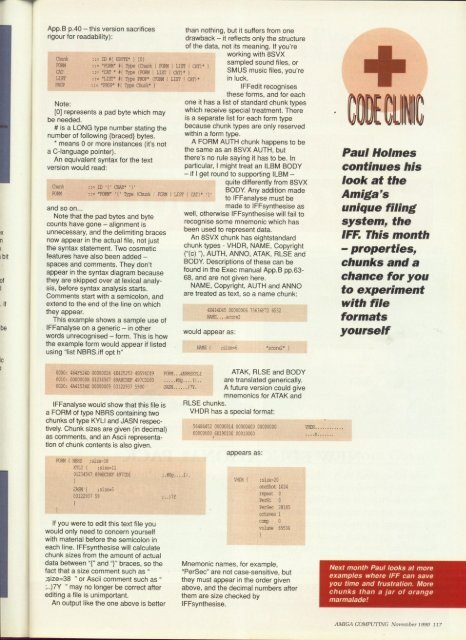Amiga Computing - Commodore Is Awesome
Amiga Computing - Commodore Is Awesome
Amiga Computing - Commodore Is Awesome
You also want an ePaper? Increase the reach of your titles
YUMPU automatically turns print PDFs into web optimized ePapers that Google loves.
App,B p.40 - this version sacrifices<br />
rigour for readability):<br />
Ounk<br />
FCRM<br />
CAT<br />
LIST<br />
PROP<br />
/D 4( uPYTE* ) [0]<br />
::= 'FORM" 4( Type (Chunk I FORM<br />
::= 'CAT ' 4( Type (FORM I LIST I<br />
::= 'UST 4( Type PROP* (FORM I<br />
u. Type Chunk* I<br />
Note:<br />
[01 represents a pad byte which may<br />
be needed.<br />
# is a LONG type number stating the<br />
number of following {braced) bytes.<br />
* means 0 or more instances (it's not<br />
a C-language pointer).<br />
An equivalent syntax for the text<br />
version would read:<br />
Chunk<br />
FORN<br />
and so on...<br />
LIST I CAT)* ]<br />
CATI* )<br />
LIST CATI*<br />
ID 'I' CMAR* 9'<br />
q. Type (Chunk I FORM Lisr I CAT(' T<br />
Note that the pad bytes and byte<br />
counts have gone - alignment is<br />
unnecessary, and the delimiting braces<br />
now appear in the actual file, not just<br />
the syntax statement. Two cosmetic<br />
features have also been added -<br />
spaces and comments. They don't<br />
appear in the syntax diagram because<br />
they are skipped over at lexical analysis,<br />
before syntax analysis starts.<br />
Comments start with a semicolon, and<br />
extend to the end of the line on which<br />
they appear.<br />
This example shows a sample use of<br />
IFFanalyse on a generic - in other<br />
words unrecognised - form. This is how<br />
the example form would appear if listed<br />
using "list NBRS.iff opt h"<br />
0000: 464F5240 00000026 4E425253 413594C49 1B1I...iNFIRSKYLI<br />
0010: 00000008 01234567 89ADCDEF 497C0100<br />
0020: 4A41534E 00010005 03122937 5900 -<br />
T A S K i n<br />
IFFanalyse would show that this file is<br />
a FORM of type NBRS containing two<br />
chunks of type KYLI and JASN respectively.<br />
Chunk sizes are given (in decimal)<br />
as comments, and an Ascii representation<br />
of chunk contents is also given.<br />
FORMI HERS :size=38<br />
:eize=11<br />
01234567 89N3CCIEF 497CD1<br />
rsize=5<br />
03122937 59<br />
If you were to edit this text file you<br />
would only need to concern yourself<br />
with material before the semicolon in<br />
each line. IFFsynthesise will calculate<br />
chunk sizes from the amount of actual<br />
data between '-{" and ")" braces, so the<br />
fact that a size comment such as<br />
;size-38 "or Ascii comment such as'<br />
may no longer be correct after<br />
editing a file is unimportant.<br />
An output like the one above is better<br />
;.4Eq....II.<br />
A<br />
than nothing, but it suffers from one<br />
drawback - it reflects only the structure<br />
of the data, not its meaning. If you're<br />
working with 8SVX<br />
sampled sound files, or<br />
SMUS music files, you're<br />
in luck.<br />
IFFedit recognises<br />
these forms, and for each<br />
one it has a list of standard chunk types<br />
which receive special treatment. There<br />
is a separate list for each form type<br />
because chunk types are only reserved<br />
within a form type.<br />
A FORM AUTH chunk happens to be<br />
the same as an 8SVX AUTH, but<br />
there's no rule saying it has to be. In<br />
particular, I might treat an ILBM BODY<br />
- if I get round to supporting ILBM -<br />
quite differently from 8SVX<br />
BODY. Any addition made<br />
to IFFanalyse must be<br />
made to IFFsynthesise as<br />
well, otherwise IFFsynthesise will fail to<br />
recognise some mnemonic which has<br />
been used to represent data.<br />
An 8SVX chunk has eightstandard<br />
chunk types - VHDR, NAME, Copyright<br />
("(c) "), AUTH, ANNO, ATAK, RLSE and<br />
BODY. Descriptions of these can be<br />
found in the Exec manual App.0 pp.63-<br />
68, and are not given here.<br />
NAME, Copyright, AUTH and ANNO<br />
are treated as text, so a name chunk:<br />
4E414E145 00000006 73636F72 6532<br />
MAME_ •score2<br />
would appear as:<br />
NAME i ;size=6 ' s c o r e r [<br />
ATAK, RLSE and BODY<br />
are translated generically.<br />
A future version could give<br />
mnemonics for ATAK and<br />
RLSE chunks.<br />
VHDR has a special format:<br />
56484452 00000014 00000400 00000001<br />
00000000<br />
,<br />
6E19010<br />
0<br />
0 0 0 1<br />
0 0 0 0<br />
appears as:<br />
'VIER ( :size=20<br />
oneShot 1024<br />
repeat 0<br />
PerRi 0<br />
PerSec 28185 81<br />
octaves 1<br />
comp 0<br />
volune 65536<br />
Mnemonic names, for example.<br />
"PerSec" are not case-sensitive, but<br />
they must appear in the order given<br />
above, and the decimal numbers after<br />
them are size checked by<br />
IFFsynthesise.<br />
VHDR<br />
....n .......<br />
INJ<br />
Paul Holmes<br />
continues his<br />
look at the<br />
<strong>Amiga</strong>'s<br />
unique filing<br />
system, the<br />
IFF: This month<br />
- properties,<br />
chunks and a<br />
chance for you<br />
to experiment<br />
with file<br />
formats<br />
yourself<br />
Next month Paul looks at more<br />
examples where IFF can save<br />
you time and frustration. More<br />
chunks than a jar of orange<br />
marmalade!<br />
AMIGA comptrutx November 1990 117
















